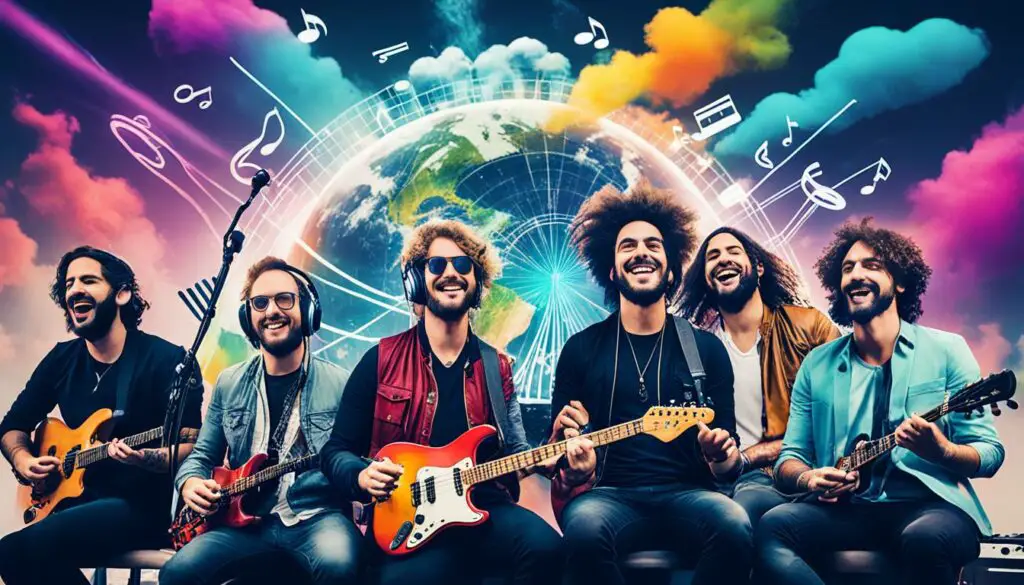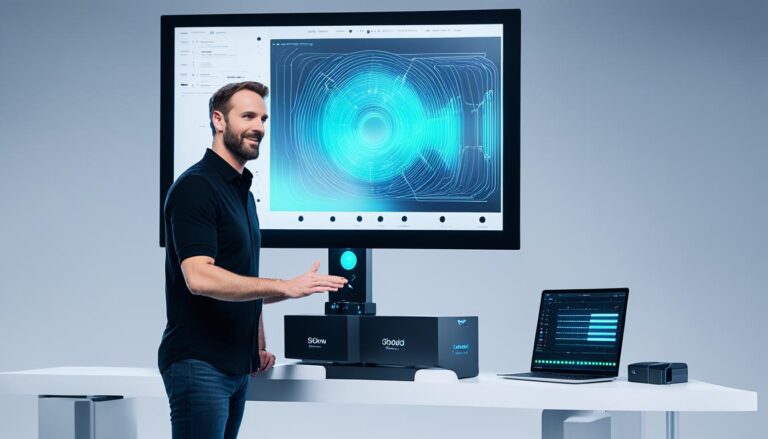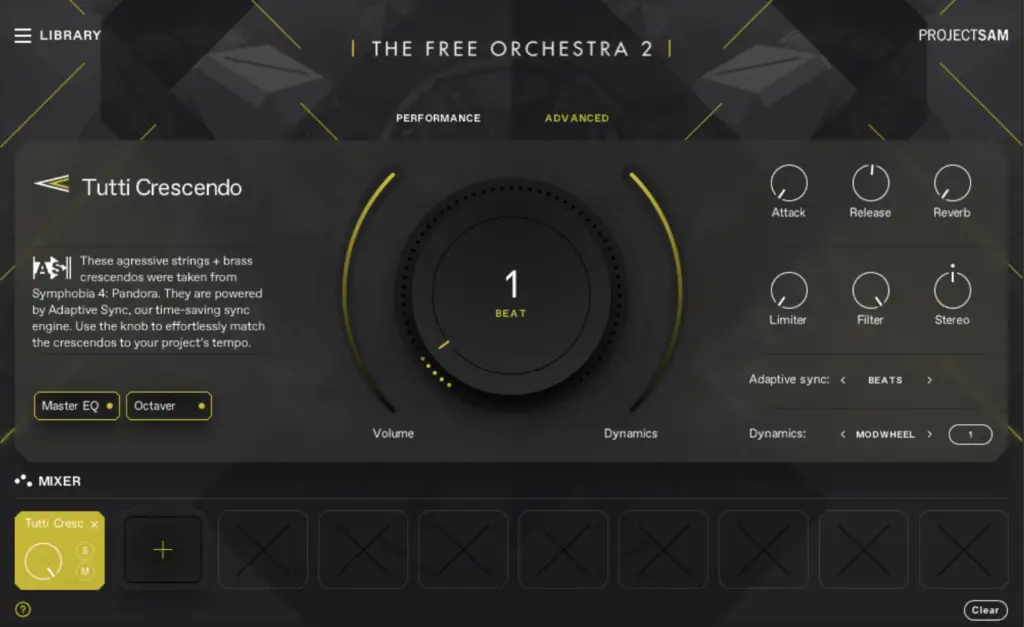Did you know the global Digital Audio Workstations (DAWs) market will reach £2.1 billion by 2028? These virtual music studios are growing fast, with a 5.85% CAGR. Companies like BandLab Technologies and Steinberg GmbH are leading the way in shaping audio production’s future.
DAWs started as simple alternatives to tape recorders in the 1970s. Now, they’re advanced platforms for complex audio tasks. They offer features like multi-track recording and MIDI integration. Musicians can now layer sounds and control virtual instruments with great precision.
Looking ahead, AI-assisted music production is set to change everything. Cloud-based DAWs are making it easier to work together. And immersive audio interfaces are getting ready to take centre stage. The future of DAWs might include predictive composition tools and virtual reality integration, starting a new era of creativity.
Key Takeaways
- The DAW market is projected to reach £2.1 billion by 2028
- A 5.85% CAGR is expected in the DAW industry
- DAWs have evolved from simple recorders to complex audio platforms
- AI and cloud technology are shaping the future of music production
- Immersive interfaces and VR integration are on the horizon for DAWs
The Evolution of Digital Audio Workstations
DAWs have changed music production since the late 1970s. They started as simple alternatives to tape recording. Now, they are complex tools for manipulating and processing audio in real-time.
From Analog to Digital: A Brief History
The story of DAWs began with Soundstream in 1977, the first digital recording. It was first used for classical and jazz. This led to more innovations in the 1980s, with Sound Designer and Cakewalk Sonar leading the way.
Key Milestones in DAW Development
The 1990s brought big changes to DAWs. Cubase Audio MAC and NotatorLogic (now Logic Pro) introduced key features. As computers got more powerful, DAWs grew from simple editors to complex recorders. They added MIDI sequencing and virtual instruments.
Current State of DAW Technology
Today, DAWs have many features like immersive audio interfaces and adaptive music scoring. They’ve changed the music industry, making ‘in the box’ mixing and film scoring easier. Despite challenges, DAWs keep evolving in audio production.
| DAW | Initial Release | Key Features |
|---|---|---|
| Cubase | 1989 | Advanced MIDI editing, VST support |
| Pro Tools | 1991 | Industry standard, robust audio editing |
| Logic | 1993 | Intuitive interface, extensive plugin library |
| Ableton | 2001 | Live performance tools, unique session view |
Looking ahead, DAWs will likely use AI, cloud collaboration, and virtual reality. This will bring new changes to making and producing music.
AI-Assisted Music Production: A Game Changer
The music industry is seeing a big change with AI-assisted music production. This new tech is changing how artists make, produce, and master their music. By 2024, AI tools for mixing and mastering have become very advanced, offering great precision and speed.
AI-powered DAWs can now look at complex audio tracks, adjust levels, and add effects with amazing accuracy. This has made making music easier for more people, giving them access to high-quality sound.
Predictive composition tools are leading this change. They look at lots of musical data to understand patterns and styles. This lets them make music in different genres with little help from humans. This has caused both excitement and worry in the music world.
“By 2024, the music landscape could be drastically different, with AI-generated music blurring the lines between human-created and machine-produced art.” – Brian May, Queen guitarist
Adding AI to music production has raised some concerns. Over 200 famous musicians, like Katy Perry and Stevie Wonder, have expressed worries about its effects. Yet, the trend keeps growing, with over 100 AI music apps now out there.
| AI Tool | Function | Key Feature |
|---|---|---|
| iZotope’s Neutron | Mixing | Advanced audio track analysis |
| LANDR | Mastering | Automated online mastering |
| OpenAI’s MuseNet | Composition | Genre versatility |
Looking ahead, it’s clear AI-assisted music production is here to stay. It’s a big change in the music world. While there are challenges, the potential for new ideas and creativity is huge.
Cloud-Based DAWs: Collaboration in the Digital Age
The music production scene is changing fast with cloud-based DAWs. These new tools are changing how artists work together, offering benefits traditional software can’t match.
Advantages of Cloud-Based Systems
Cloud-based DAWs are changing how musicians work together from different places. Artists can share ideas and tracks instantly, no matter where they are in the world. This has made it easier for people from all over to make music together, breaking down distance barriers.
Challenges and Solutions in Cloud DAWs
Cloud DAWs have many benefits but also face challenges. Security and speed issues have been big concerns. But, developers are working hard to fix these with better encryption and low-latency tech. This keeps music collaboration safe and smooth.
Leading Cloud DAW Platforms
Some platforms are at the forefront of cloud music production. Let’s explore the leaders:
| Platform | Key Features | Collaboration Capabilities |
|---|---|---|
| Soundtrap | User-friendly interface, built-in loops and instruments | Real-time collaboration, chat function |
| BandLab | Free to use, mobile app available | Unlimited collaborators, social networking features |
| Avid Cloud Collaboration | Professional-grade tools, integration with Pro Tools | Project sharing, track changes |
These platforms are setting the stage for a new music creation era. With cloud DAWs getting better, we’ll see more new features. This will make working together on music even better.

Immersive Audio Interfaces: The Next Frontier
The world of sound design is changing fast, with immersive audio interfaces at the forefront. These new tools are changing how we make and hear sound. They bring a new level of depth and realism.
Formats like Dolby Atmos, DTS:X, and Ambisonics are becoming popular in music, film, and games. They’re not just new terms; they’re changing how we hear sounds. Imagine being surrounded by sound, where every note and effect has its own space in a three-dimensional world.
3D sound design is now a reality, not just a dream. It’s changing how we make audio. Sound designers can now use speaker setups from 5.1.2 to 11.1.6. This gives them a huge space to be creative with sound.
“Spatial audio is not just about adding more speakers. It’s about creating a new dimension in sound,” says a renowned audio engineer.
Spacial audio technologies are bringing new ideas to the table. Companies like DearVR and Fraunhofer are making tools for creating soundscapes in three dimensions. This is pushing the limits of what’s possible in making audio.
We’re at the start of a big change in audio, and it’s clear that immersive audio interfaces are here to stay. They promise to give us richer, more engaging experiences that feel truly magical.
What Future Digital Audio Workstations Could Look Like
The music production world is changing fast. Digital Audio Workstations (DAWs) are getting better quickly. They will change how musicians and producers work.
Predictive Composition Tools
Imagine a DAW that guesses your musical ideas before you start. Predictive composition tools are coming soon. They look at your past work, what you like, and your current project. Then, they suggest melodies, harmonies, and song structures.
It’s like having a virtual partner who knows your style well.
VR in Music Production
Virtual reality will change how we use DAWs. Picture being in a 3D audio world where you can move around your track. You can change sounds with your hands, like they’re real objects.
VR in music production is more than just a new feature. It could make making music more natural and engaging.
Biometric Audio Control Systems
The next DAWs might use your body to control sounds. You could use gestures, heart rate, or brain waves to change sounds. Imagine tweaking a synth with a hand gesture or adjusting reverb with your breath.
These new tools could make making music more natural and expressive.
As DAWs get better, they will mix human creativity with new technology. The future of music production looks exciting. It will have tools that make making music more intuitive, immersive, and inspiring.
Adaptive Music Scoring: Revolutionising Film and Game Audio
Adaptive music scoring is changing how we make film and game audio. It lets soundtracks change in real-time with the action and story, making the experience more engaging for everyone.

Video games have been using adaptive music for over 40 years. One of the first examples was in 1978 with Space Invaders. The music’s tempo changed with the game’s pace.
Now, we’re seeing a big change in how we make interactive soundtracks. Tools like Digital Audio Workstations (DAWs) are getting better at handling dynamic audio. This lets composers make music that responds to what’s happening in the game.
There are two main ways adaptive music works in games. Vertical layering adds or removes music parts based on game events. Horizontal resequencing changes the music’s structure in response to the game.
- Machine learning and generative algorithms are improving how we make and deliver game music.
- AI-enhanced biofeedback systems are being developed to measure and adapt to gamers’ emotions.
- FMOD and WWISE are popular tools that let us change musical elements in real-time.
As technology gets better, we’ll see even more advanced adaptive music scoring. These new techniques will make the music in films and games more interactive and emotionally engaging.
Real-Time Audio Processing: Breaking the Latency Barrier
Real-time audio processing has made huge strides, changing the music world with low-latency tech. This change deeply affects live performance tech. It now shapes how musicians connect with their gear and the crowd.
Advancements in Low-Latency Technology
Latency, or the delay between what you play and what you hear, was a big problem. New tech has cut this delay way down. Now, singers can feel a delay of just three milliseconds, making their performances more accurate.
| Year | Audio Dynamic Range |
|---|---|
| 1890 | 15 dB |
| Present | 110-115 dB |
Impact on Live Performance and Recording
Low-latency tech has changed live shows for the better. Musicians can use digital effects without delay, making their performances more exciting. In studios, this tech means instant feedback, making music production faster.
Future Applications in Remote Collaboration
The future of real-time audio looks promising. By 2030, we’ll see super-realistic audio in all portable devices and games. This tech will make working together from afar easy, letting musicians jam together from anywhere in the world.
“Over the next 20 to 30 years, 3D sound-field production and design are expected to be significant growth areas in pro audio.”
As live performance tech keeps getting better, we’re moving towards a future where the line between real and virtual music experiences gets blurry. This opens up new chances for artists and fans.
Audio-Visual Integration: Bridging the Gap
The world of digital audio workstations (DAWs) is changing fast. At the heart of this change is the blending of audio and visual elements. This is making it easier for creators to work on film scores, music videos, and live shows.
Before, audio and visuals were separate. Now, DAWs bring them together in one place. This change is big news for the creative world.
In film and gaming, this integration is really showing up. Courses like VFX Artists on Set and LED Systems for Film Professionals are becoming popular. They teach how to mix old-school filmmaking with new tech. We’re also seeing more use of green-screen and LED ICVFX in making movies.
| Aspect | Impact on Synchronized Media Production |
|---|---|
| Virtual Production | Increased use of real-time game engines like Unreal Engine |
| Workflow | Shift towards 2.5D mix of 2D and 3D playback |
| Pre-production | Greater investment in planning to reduce post-production needs |
| Tools | ‘Disguise’ emerging as a global standard for virtual production |
Looking ahead, the gap between audio and visual production will keep getting smaller. Future DAWs will have even more tools for mixing audio and visuals. This will let creators make synchronized media like never before.
Blockchain and DAWs: Redefining Music Distribution
The music industry is on the brink of a big change, thanks to blockchain technology. This new system could change how music is shared and made money from. It’s set to give musicians new ways to express themselves and earn money.
Smart Contracts for Royalty Management
Smart contracts are here to simplify how royalties work. They’re like smart versions of traditional contracts. These contracts pay artists automatically, cutting out the middlemen. It’s a solution that benefits everyone involved.
Decentralised Audio Storage and Sharing
Picture a world where your music is kept safe on a network of computers, not just one server. That’s what decentralised audio storage offers. Platforms like Muti on NEAR are already making this a reality, letting musicians share their music in new ways.
Tokenisation of Music Assets
Now, owning a piece of a song isn’t just for the big names. Tokenisation is making music ownership open to everyone. This blockchain method is creating new ways for artists to make money and connecting them closer to their fans. It’s a blend of tech and art that’s shaping the future of music.



